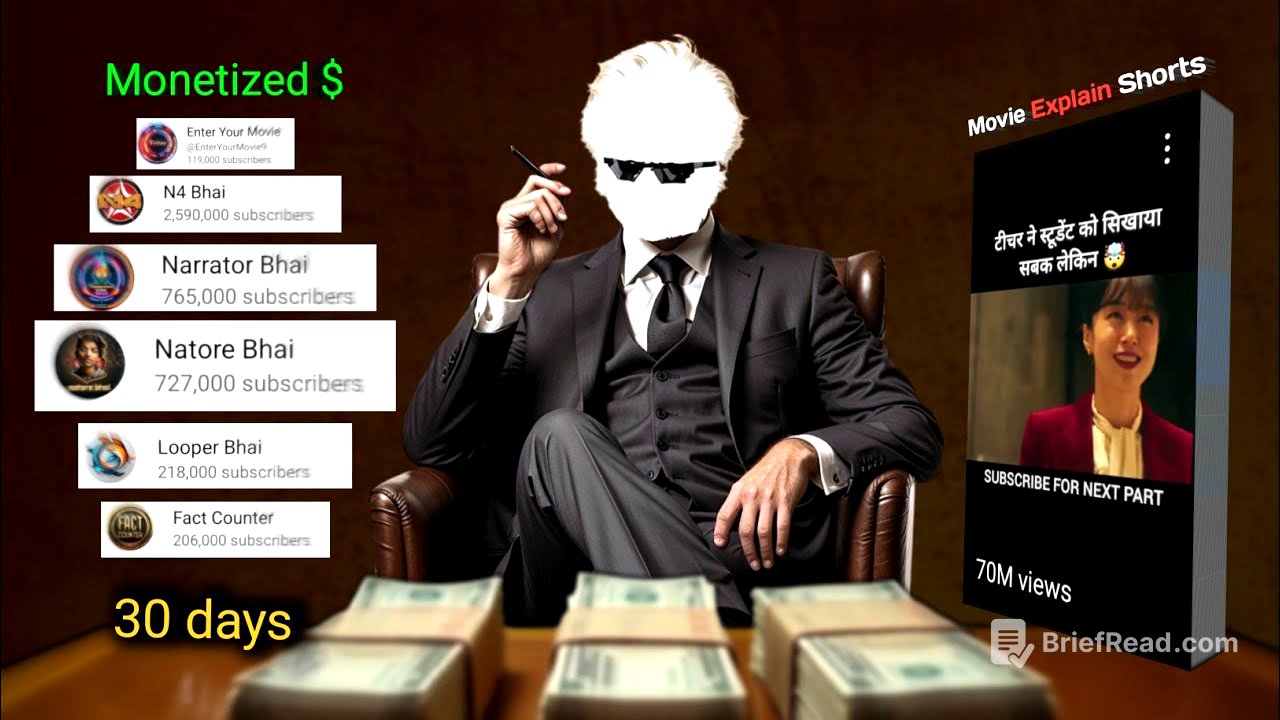TLDR;
This video details an experiment on growing and monetising new YouTube channels, focusing on overcoming the initial hurdle of zero views. It covers the creation of multiple channels, the strategies used to gain subscribers and views, and the challenges faced with reused content and demonetisation. The video also provides a step-by-step guide on creating movie explanation short videos using content from the Kwaishu application, translating and editing the content, and using AI for voiceovers.
- Experiment on growing new YouTube channels
- Strategies to gain subscribers and views
- Overcoming demonetisation due to reused content
- Step-by-step guide to creating movie explanation short videos
Intro: The Experiment [0:02]
The video introduces an experiment conducted over the last five months, focusing on how to grow a new YouTube channel. The creator made multiple channels, many of which were monetised, and promises to share the earnings from these channels. The experiment involved extensive research, revealing patterns that address the common problem of zero views for new YouTubers. The creator claims to have found a way to overcome this initial hurdle.
Creating the First Channel: Narrator Bhai [0:43]
On 26th June 2024, the creator decided to make a challenge video, inspired by the viral 30-day shorts challenge. The next day, 27th June 2024, they created a channel named Narrator Bhai. The initial plan was to create professional movie explanation shorts, but the creator sought an easier method due to being "lazy". Copy-pasting content directly from YouTube was not an option, as their channel M4 Bhai had already been demonetised for reused content.
Finding a Solution: The Kwaishu App [1:21]
To avoid extensive work while still monetising the channel, the creator looked for a way to create videos by copy-pasting. This led them to the Kwaishu application, where they found numerous movie explanation short videos in Chinese. They decided to take a video, modify it, and convert it into Hindi. The creator demonstrates the transformation of a video about a hostel, explaining that the content is no longer directly sourced from YouTube.
Initial Uploads and the Struggle for Views [2:07]
The first video was uploaded on 27th June 2024. The creator started uploading one video every day, but initially, the channel received no views. After seven days and seven videos, the fourth video gained 2,500 views, resulting in two subscribers. This small success made the creator happy, signalling the beginning of viewership.
Growth in Views and Subscribers [2:36]
The sixth video started attracting views, and the channel gained 17 subscribers. Gradually, the views and subscribers increased, reaching 100 subscribers after 15 days and 200 after 19 days. Motivated by this growth, the creator considered uploading two videos per day. After 21 days, the channel had 350 subscribers, falling short of the initial goal of 100,000 subscribers in 30 days.
Exponential Growth and Suspicion [3:23]
After 23 days, the channel reached 1,000 subscribers, and the next morning, it surpassed 1,500. By the afternoon, the channel had over 2,200 subscribers. On 23rd July 2024, 26 days after the channel's creation, the creator noted that the channel was getting over 700,000 views in one hour, raising suspicions.
Rapid Subscriber Increase and Monetisation Concerns [4:17]
On 24th July 2024, with only three days left in the 30-day challenge, the channel had over 30,000 subscribers. The creator was surprised by this sudden increase. Within 48 hours, the channel accumulated over 16 million views. Despite the success, the creator worried about monetisation, recalling the demonetisation of their N4 Bhai channel due to reused content.
Applying for Monetisation and Overcoming Fears [5:02]
The creator applied for monetisation on 25th July without deleting any videos, treating it as an experiment to find solutions to potential problems. Having an existing Adsense account expedited the application process. To the creator's surprise, the channel was monetised 29 days after its creation, with over 60,000 subscribers.
Reaching 100,000 Subscribers and Plan B [5:50]
Despite being monetised, the channel couldn't immediately generate income as it hadn't reached 10 million views in the area where views are counted for monetisation. On 29th July 2024, the Narrator Bhai channel reached 100,000 subscribers. The initial plan to gain 100,000 subscribers in 30 days had failed, but the creator had already initiated "Plan B".
Plan B: Creating Additional Channels [7:00]
On 23rd July 2024, with only 11,000 subscribers on the first channel and six days left in the 30-day period, the creator launched another channel. Views started coming on the third video within three days. The channel quickly grew, reaching over 1,000 subscribers in 12 days and over 3,000 in 13 days. After 14 days, it had 4,000 subscribers, and after 18 days, it reached 10,000 subscribers.
Monetisation of the Second Channel and Subsequent Failures [7:35]
After 23 days, the second channel had 13,000 subscribers and over 3 million views, prompting the creator to apply for monetisation, which was approved the next day. However, with only 16,000 subscribers and two days remaining, reaching 100,000 subscribers in 30 days was impossible. The channel reached 24,000 subscribers in 30 days, and eventually hit 100,000 in 49 days. The creator created additional channels, experiencing initial success with views but facing monetisation rejections due to reused content.
The Reused Content Problem and a Potential Solution [8:29]
The creator faced repeated rejections for monetisation due to reused content, suspecting that the widespread use of the Kwaishu app was the cause. To address this, they deleted most videos from a channel, leaving only two movie explainer videos with 10 million views. They then dubbed Chinese drama videos into Hindi and uploaded them, hoping to monetise the channel based on the original movie explainer content and the new, original dubbed content.
Successful Monetisation Through a Hybrid Approach [9:57]
The creator re-applied for monetisation, believing that the combination of the popular movie explainer videos and the original dubbed content would be successful. The channel was indeed monetised, validating this approach. However, a similar attempt on another channel failed initially.
The Appeal Process and Final Monetisation [10:36]
The creator realised they had uploaded multiple videos too quickly on the second channel before re-applying for monetisation. Instead of waiting three months, they created an appeal video, uploaded it as unlisted, and submitted the link. The appeal was successful, and the channel was monetised. The creator provides a Google Drive link in the description with the appeal video and channel screenshots.
Earnings and the Process of Creating Videos [11:36]
The creator shares earnings from the channels, noting that one channel earned around ₹4,000 on the first day and ₹2,500 on the second day. They also show lifetime earnings from various channels. The video then transitions into a step-by-step guide on creating similar videos.
Step-by-Step Guide: Finding and Downloading Content [12:19]
The guide begins with downloading the Kwaishu application and finding movie explanation videos. The creator recommends using Google Translate to convert movie explanation text into Chinese for searching. They also suggest searching for specific channels and copying video links to download using video downloader apps from the Play Store.
Step-by-Step Guide: Translating and Creating Voiceovers [12:56]
The next step involves using the Sound Type A application to get a voice-over script of the video in Chinese, which is then translated into Hindi using Chat GPT. The creator advises writing a prompt for Chat GPT to analyse the Chinese script and translate it into a professional-sounding Hindi script. For creating the voice, the creator recommends using the 11 Labs website, mentioning a previous video that explains how to create multiple accounts for free use.
Step-by-Step Guide: Editing the Voiceover [14:26]
The voiceover is edited using the Gold Wave Audio Editor application. The creator outlines three essential effects: silence reduction, auto gain, and time change. Silence reduction removes silent parts, auto gain adjusts the audio levels, and time change allows controlling the speed of the voiceover.
Step-by-Step Guide: Video Editing and Uploading [15:56]
The final steps involve importing the video into an editing app, setting the project ratio to 9:16, cropping subtitles, and zooming the video. The edited audio is added, and the video is edited to match the audio. Text in Hindi and emojis are added, along with background music. The video is then exported to 1080p. During upload, the 'Altered content' option is selected due to the use of AI voice. The creator advises uploading videos at the same time every day and reiterates the monetisation process.









